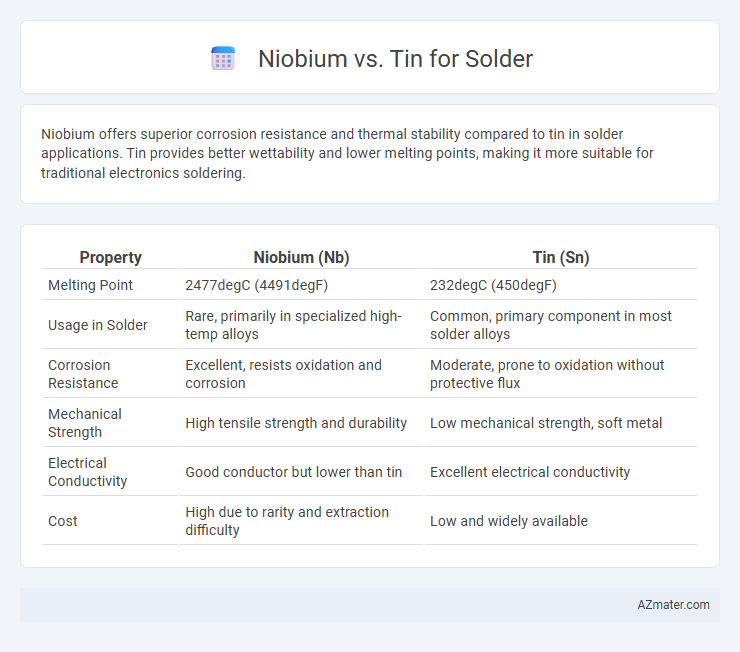Niobium offers superior corrosion resistance and thermal stability compared to tin in solder applications. Tin provides better wettability and lower melting points, making it more suitable for traditional electronics soldering.
Table of Comparison
| Property | Niobium (Nb) | Tin (Sn) |
|---|---|---|
| Melting Point | 2477degC (4491degF) | 232degC (450degF) |
| Usage in Solder | Rare, primarily in specialized high-temp alloys | Common, primary component in most solder alloys |
| Corrosion Resistance | Excellent, resists oxidation and corrosion | Moderate, prone to oxidation without protective flux |
| Mechanical Strength | High tensile strength and durability | Low mechanical strength, soft metal |
| Electrical Conductivity | Good conductor but lower than tin | Excellent electrical conductivity |
| Cost | High due to rarity and extraction difficulty | Low and widely available |
Introduction: Niobium vs Tin in Soldering
Niobium offers superior corrosion resistance and higher melting point compared to tin, making it ideal for high-temperature soldering applications. Tin, commonly used in solder alloys, provides excellent wettability and electrical conductivity but has a lower melting point and is prone to oxidation. Choosing between niobium and tin solder depends on the specific performance requirements, such as durability and thermal stability in electronic components.
Chemical Properties and Reactivity
Niobium exhibits high corrosion resistance and low chemical reactivity due to its strong oxide passive layer, making it stable in soldering applications. Tin, with its lower melting point and higher chemical reactivity, readily forms intermetallic compounds during soldering, enhancing joint formation but potentially affecting corrosion resistance. The distinct differences in oxidation behavior and alloy compatibility make niobium preferable for environments demanding chemical stability, while tin's properties favor conventional soldering performance.
Melting Points and Thermal Characteristics
Niobium has a melting point of approximately 2,468degC, significantly higher than tin's melting point at about 232degC, making niobium unsuitable for conventional soldering applications that require low melting temperatures. Tin, often used in solder alloys, exhibits excellent thermal conductivity and a low melting point, enabling efficient heat transfer and solidification during soldering. The thermal expansion coefficient of tin alloys is also well-matched to electronic components, reducing thermal stress compared to refractory metals like niobium.
Electrical Conductivity Comparison
Niobium exhibits significantly higher electrical conductivity than tin, making it a superior choice for solder applications requiring efficient electrical flow. Tin's electrical conductivity is lower, which can lead to increased resistance and potential signal loss in high-performance electronic joints. Using niobium in solder enhances circuit reliability and performance, especially in high-frequency or high-current environments.
Mechanical Strength and Durability
Niobium-based solder exhibits superior mechanical strength compared to tin solder, offering enhanced resistance to stress and fatigue in demanding applications. The durability of niobium alloys results in longer-lasting joints, especially in environments subject to thermal cycling and mechanical vibration. Tin solder, while widely used for its low melting point and ease of application, generally provides lower tensile strength and can suffer from creep and joint degradation over time.
Oxidation Resistance and Corrosion
Niobium exhibits superior oxidation resistance compared to tin, forming a stable oxide layer that protects the solder joint from atmospheric degradation during high-temperature applications. Tin, while widely used in solder alloys, tends to oxidize readily, leading to weaker joint integrity and increased risk of corrosion under humid or chemically aggressive environments. The enhanced corrosion resistance of niobium-based solder alloys makes them preferable in electronics requiring long-term reliability and minimal maintenance.
Industry Applications and Use Cases
Niobium exhibits superior corrosion resistance and high melting point, making it ideal for aerospace, automotive, and electronics industries where durability and thermal stability are critical. Tin, with its excellent wettability and low melting point, dominates electronics soldering and plumbing, enabling reliable electrical connections and leak-proof joints. Industry use cases favor niobium for high-performance, harsh environment components, while tin is preferred for mass production of circuit boards and household plumbing systems.
Environmental Impact and Toxicity
Niobium is favored in solder applications for its low toxicity and minimal environmental impact, as it is a stable, inert metal that does not release harmful substances during use or disposal. Tin, while widely used in solder, can pose environmental challenges due to the extraction processes and the potential release of toxic compounds like stannous and stannic oxides. Choosing niobium over tin reduces the ecological footprint and health risks associated with soldering materials, supporting sustainable electronics manufacturing.
Cost and Material Availability
Niobium offers superior corrosion resistance and high melting points but is significantly more expensive and less abundant than tin, making it less practical for standard soldering applications. Tin, widely available and cost-effective, dominates solder production due to its excellent wettability and lower melting temperature, facilitating easier manufacturing and repair processes. The limited global supply and higher extraction costs of niobium inhibit its widespread adoption in solder compared to the economical and readily available tin-based alloys.
Conclusion: Choosing Between Niobium and Tin for Solder
Niobium offers superior corrosion resistance and high melting point, making it ideal for specialized electronic applications requiring durability and thermal stability. Tin, widely used in traditional solder alloys, provides excellent wettability and cost-efficiency for everyday electronics manufacturing. Selecting between niobium and tin solder depends on balancing application-specific reliability needs against budget constraints and manufacturing scale.

Infographic: Niobium vs Tin for Solder
 azmater.com
azmater.com